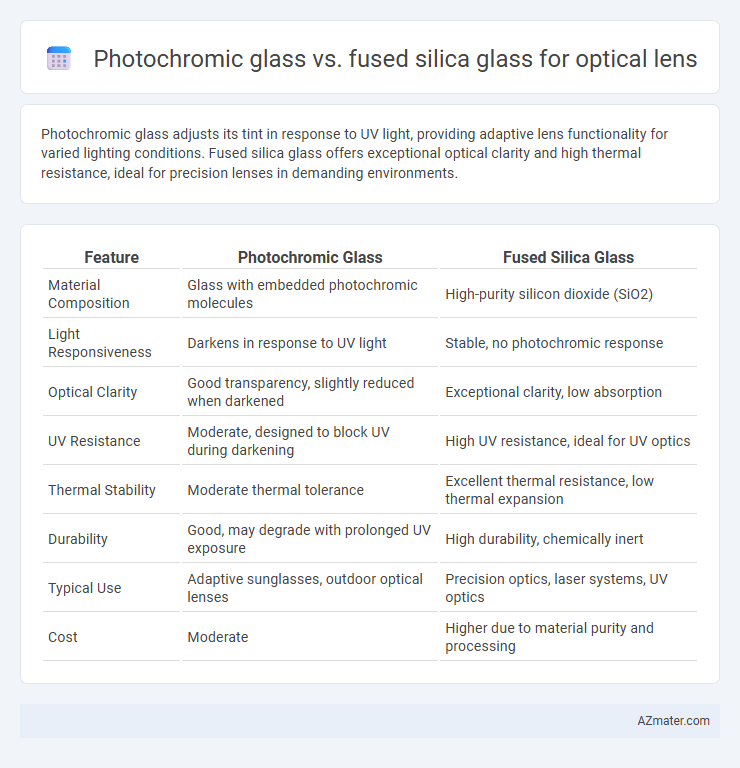Photochromic glass adjusts its tint in response to UV light, providing adaptive lens functionality for varied lighting conditions. Fused silica glass offers exceptional optical clarity and high thermal resistance, ideal for precision lenses in demanding environments.
Table of Comparison
| Feature | Photochromic Glass | Fused Silica Glass |
|---|---|---|
| Material Composition | Glass with embedded photochromic molecules | High-purity silicon dioxide (SiO2) |
| Light Responsiveness | Darkens in response to UV light | Stable, no photochromic response |
| Optical Clarity | Good transparency, slightly reduced when darkened | Exceptional clarity, low absorption |
| UV Resistance | Moderate, designed to block UV during darkening | High UV resistance, ideal for UV optics |
| Thermal Stability | Moderate thermal tolerance | Excellent thermal resistance, low thermal expansion |
| Durability | Good, may degrade with prolonged UV exposure | High durability, chemically inert |
| Typical Use | Adaptive sunglasses, outdoor optical lenses | Precision optics, laser systems, UV optics |
| Cost | Moderate | Higher due to material purity and processing |
Introduction to Optical Lens Materials
Photochromic glass and fused silica glass are critical materials in optical lens manufacturing due to their unique properties. Photochromic glass offers dynamic light modulation by darkening in response to UV radiation, enhancing visual comfort and protection, whereas fused silica glass exhibits exceptional thermal stability, low thermal expansion, and high optical clarity, making it ideal for precision optics in extreme environments. Selection between these materials depends on application-specific requirements such as UV sensitivity, environmental durability, and optical performance standards.
Overview of Photochromic Glass
Photochromic glass contains molecules that undergo reversible chemical reactions when exposed to ultraviolet (UV) light, allowing the lens to darken automatically and provide adaptive light filtration. This dynamic tinting property improves visual comfort by reducing glare and enhancing contrast in varying lighting conditions without the need for manual lens changes. Compared to fused silica glass, which is valued for its exceptional transparency and thermal stability but lacks photo-reactive capabilities, photochromic glass offers the advantage of smart light modulation for optical lenses.
Properties of Fused Silica Glass
Fused silica glass offers exceptional optical clarity, high resistance to thermal expansion, and superior UV transparency compared to photochromic glass, making it ideal for precision optical lenses. Its low refractive index and excellent homogeneity enable minimal distortion and high image quality in demanding applications such as lithography and laser systems. The material's remarkable chemical inertness and high melting point ensure durability and performance stability in extreme environments.
Optical Performance Comparison
Photochromic glass offers dynamic light modulation by darkening in response to UV exposure, providing variable transmittance and enhanced glare reduction for optical lenses. Fused silica glass exhibits superior optical clarity with minimal birefringence, high UV transparency, and excellent thermal stability, making it ideal for precision lens applications. While photochromic glass excels in adaptive vision and comfort, fused silica delivers unmatched optical resolution and durability essential for high-performance imaging systems.
Light Transmission and Clarity
Photochromic glass adjusts its tint in response to UV light, reducing light transmission in bright conditions while maintaining clarity in low light, making it ideal for dynamic lighting environments. Fused silica glass offers superior optical clarity with high light transmission rates, minimal chromatic aberration, and excellent thermal stability, preferred for precision optics and high-performance lenses. For applications demanding consistent clarity and maximum light transmission, fused silica glass outperforms photochromic glass in optical lens manufacturing.
UV Protection Capabilities
Photochromic glass offers dynamic UV protection by darkening upon exposure to ultraviolet light, effectively reducing UV radiation transmission and enhancing eye safety in varying light conditions. Fused silica glass inherently blocks most UV radiation due to its high purity and low impurity content, providing consistent UV protection without changing optical properties. For optical lenses, fused silica glass ensures stable UV filtration, while photochromic glass combines UV protection with adaptive light modulation.
Durability and Scratch Resistance
Photochromic glass offers moderate durability with the added benefit of adaptive light filtering but tends to be more prone to surface scratches compared to fused silica glass. Fused silica glass excels in scratch resistance due to its high hardness and chemical inertness, making it ideal for long-lasting optical lenses in harsh environments. The superior thermal and mechanical stability of fused silica further enhances its durability, outperforming photochromic glass in demanding optical applications.
Thermal and Chemical Stability
Photochromic glass offers moderate thermal stability but can degrade with prolonged UV exposure and temperature fluctuations, whereas fused silica glass exhibits exceptional thermal resistance with a melting point around 1710degC and minimal thermal expansion. Chemically, fused silica glass remains highly inert and resistant to acids and alkalis, outperforming photochromic glass, which may experience chemical degradation over time due to its organic photochromic compounds. The superior thermal and chemical stability of fused silica makes it preferable for precision optical lenses operating under extreme environmental conditions.
Suitability for Different Optical Applications
Photochromic glass offers dynamic light modulation by darkening in response to UV exposure, making it ideal for eyewear and adaptive optical systems that require variable light control. Fused silica glass exhibits exceptional thermal stability, high transparency from UV to IR wavelengths, and low thermal expansion, making it suitable for high-precision optical applications such as laser systems, fiber optics, and lithography. The choice between photochromic and fused silica glass depends on the application's need for either variable light modulation or superior optical clarity and durability under extreme environmental conditions.
Cost-Effectiveness and Availability
Photochromic glass often offers higher cost-effectiveness for optical lenses due to its adaptive light-filtering properties, reducing the need for multiple lens pairs and enhancing user convenience. Fused silica glass, while providing superior optical clarity and thermal stability, generally comes with higher production costs and limited availability compared to photochromic alternatives. Manufacturers must balance performance requirements against budget constraints and supply chain factors when choosing between these materials for optical lens applications.

Infographic: Photochromic glass vs Fused silica glass for Optical lens
 azmater.com
azmater.com